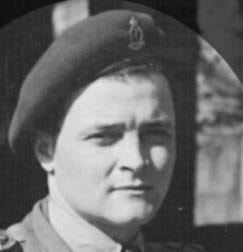By Carson Ellis
Stettler-born Patrick G. Costigan was a graduate of medicine from the U of A.
He joined the army as a private in 1941 and was promoted to lieutenant when he graduated in 1942. He then became a captain after six months and went overseas in July of 1944.
Captain Costigan was attached to the 1st Canadian Parachute Battalion when they were air dropped across the Rhine in June of 1944.
The German forces were both in front and behind the Canadians.
Although it was a clear day, which increased the success rate of an accurate drop, and the Luftwaffe did not intercept their aircraft, there was heavy Flak fire.
When the planes dropped to 600 ft. they were also exposed to German machine guns mounted at high points along the area.
Captain Costigan noted that although it took roughly 30 seconds to drop, it felt like two years. Costigan’s medical contingent included 18 medical orderlies. They were carrying enough blood plasma, penicillin and other supplies to treat 300 casualties.
Within 30 minutes of landing, Costigan and his fellow doctors had set up a make-shift hospital in a church. The medical team would treat approximately 250 casualties in the first 36 hours - a bulk of that happening within the first 15 minutes.
Also attached to the unit was well-known Winnipeg Blue Bomber (Colonel) Jeff Nicklin who came down in a tree right over an enemy trench. NHL star Vince Germain was also killed the same day.
The paratroopers would form the spearhead of the British attack.
They were noted as being the first British/Canadian troops to encounter the Russians who they met with at Wismar. Their united advance would bring them to the Baltic Sea two days before VE Day.
Costigan would also provide medical aid to the prisoners of the Bergen-Belsen concentration camp upon Allied liberation.
He explained that, “Pictures don’t show the worst part.”
He noted Typhus as one of the biggest medical issues and explained that inmates were dying at a rate of nearly 900 per day, reaching almost 1,300 per day at one point.
Nazi commanders bartered a truce with the Allied forces, allowing the defeated Germans to withdraw safely from the area. However, the good faith of the Allied commanders was returned by the retreating Germans by the sabotaging of the lights and water systems.
Due to the rather unfortunate nature of other events noted by Costigan during his time at the camp, I have opted not to include them in this article.
As for Costigan, after military service, he began practicing in Banff.
It should be noted he gave medical treatment to Joe DiMaggio, Marilyn Monroe, Alan Arkin, and several others while they were in the Banff area filming River of No Return in 1953.
He once joked that while treating Miss Monroe for a fractured ankle, he was so distracted by her beauty, he almost put a cast on the wrong ankle.
Dr. Costigan was also a talented hockey player, and coached an NHL All-Star team in Banff in 1972. The team would include Bobby Orr and Gary Unger.
Patrick Gerald Costigan died peacefully in Banff at 56 in 1973.
He was a well-respected member of the community and was recognized by the local Legion branch for his dedicated efforts in ensuring military veterans and their families received their proper pensions and funding.
